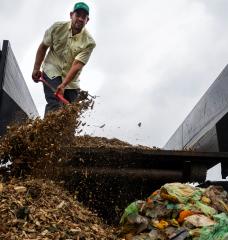
By Mark Dwortzan | MIT Center for Sustainability Science and Strategy
Study shows how ‘optimized’ diets could reduce malnutrition and environmental degradation
“You are what you eat.”
When it comes to the Earth and humanity, that phrase might well be viewed as a warning. As it damages ecosystems around the world, today’s global food system leaves more than 700 million people undernourished. Anchored in agricultural practices that contribute significantly to climate-warming greenhouse gas emissions, water pollution and biodiversity loss, that system remains a clear and present danger to the planet and its inhabitants. However, new findings show that several types of diet—ranging from fully plant-based to flexible, modestly meat-inclusive—could reduce environmental impacts and malnutrition considerably.
To determine a range of diets that could achieve that objective, researchers at the Technical University of Denmark and MIT Center for Sustainability Science and Strategy (CS3) have developed a model designed to optimize environmental and human health. The model pinpoints food combinations within different diets that meet both environmental limits (climate change, land use, water consumption and pollution, and biodiversity loss) and nutritional requirements based on an average adult’s needs.
A toolkit for action
Applying those specifications to a dataset of more than 2,500 U.S.-specific food items, the researchers find that diets optimized for environmental and nutritional constraints generally include 20-40 servings per week of grains and vegetables, and 10-20 servings per week of nuts, seeds and fruits—levels that far exceed those in typical U.S. diets. The optimized diets also limit dairy and animal-based proteins (ideally 255 grams or less of pork or poultry) to less than four servings per week—much lower than what’s consumed in U.S. diets, with grains, legumes and nuts as primary protein sources.
Aligned with the Paris Agreement’s long-term goal of capping global warming at 1.5 degrees Celsius, the optimal diets reduce food-based climate impacts by a factor of seven and provide up to 700 additional minutes of healthy life per week. The researchers present eight pre-defined optimal dietary patterns that offer a wider palette of environmentally/nutritionally beneficial foods than those proposed in earlier studies.
Their results appear in the journal Nature Food.
“Whereas previous research on dietary optimization provides little direction beyond recommending a shift from meat-based to plant-based diets, our results indicate that multiple diets (and not all of them meatless) can satisfy strict environmental and nutritional goals,” says Etienne Berthet, a postdoctoral associate at MIT CS3. “We’ve pinpointed how much meat—up to 255 grams per week for strict adherence to the 1.5°C target—can fit into a healthy diet without overshooting individual environmental limits, while still covering all essential nutrients like protein, carbohydrates and fats. This gives people a toolkit for action with practical metrics to guide their choices rather than imposing a one-size-fits-all or dogmatic approach”
While the study is based on the U.S. diet, its methods could be customized to other regions, food cultures and environmental/health constraints.






